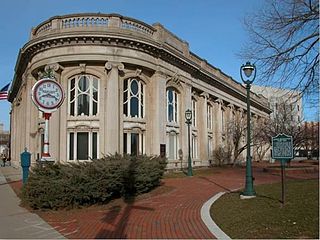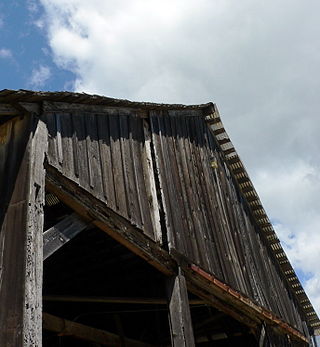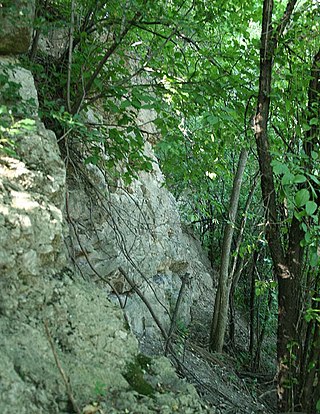
Cedarburg is a town in Ozaukee County, Wisconsin, United States, and is in the Milwaukee metropolitan area. The town was created in 1849 and at the time of the 2020 census had a population of 6,162.

Grafton is a village in Ozaukee County, Wisconsin, United States. Located about 20 miles (32 km) north of Milwaukee and in close proximity to Interstate 43, it is a suburban community in the Milwaukee metropolitan area. The village incorporated in 1896, and at the time of the 2020 census the population was 12,094.

Limekiln State Park is a California state park on the Big Sur coast. It contains four lime kilns from an 1887–1890 lime-calcining operation, plus a beach, redwood forest, and 100-foot (30 m) Limekiln Falls. It is located 2 miles (3.2 km) south of Lucia on Big Sur Coast Highway. The 711-acre (288 ha) park was established in 1994.

Wouldham is a village on the bank of the River Medway in Kent, England. In 2011 its population was approximately 1500, which has increased since 2017, with substantial housing development to the south of the village. It has an 11th-century church, two schools – a primary school and one for those with special educational needs, and two public houses, The Medway Inn and The Waterman's Arms.

Geilston Bay is a largely residential suburb of Hobart between Risdon Vale, Shag Bay, and Lindisfarne, in the City of Clarence located on the Eastern Shore of the Derwent River, taking its name from an inlet of that river of the same name. The inlet and locality were sometimes known by the alternative name "Limekiln Bay" on account of lime kilns which operated there between approximately the 1830s and the 1920s, the remains of which remained visible for some decades thereafter; another early name for the Bay was "James's Bay". The present suburb name derives from an early land holding "Geils Town" in the region purchased by Andrew Geils, Commandant of Van Diemen's Land (Tasmania) for a brief period in 1812-1813, who subsequently left his Australian holdings behind when he moved back to Scotland.

Trimborn Farm is a Victorian era estate located in Greendale, Wisconsin, United States, and owned by Milwaukee County. Spanning 7.5 acres and nine buildings, it is listed on the National Register of Historic Places. The farm is also a State Historic Site and designated Milwaukee County Landmark.

Castle Bytham quarry is a disused quarry located close to the centre of the village of Castle Bytham, Lincolnshire, England. It is famous for the exposure of Laeviuscula Zone ammonite fauna has allowed the dating of the Upper Lincolnshire limestone formation to the Bajocian era, and thereby dating other deposits around Europe.
The Griggsville Landing Lime Kiln is located near village of Valley City, Illinois in Pike County. The periodic lime kiln is listed on the National Register of Historic Places, a designation it gained in August 1999. It is actually within the boundaries of the Ray Norbut State Fish and Wildlife Area. The kiln represents an example of an 1850s lime kiln, one of the best-preserved examples of such a kiln. In its heyday the kiln's raw product would have been quicklime. The kiln is one of twelve Pike County sites included in the National Register of Historic Places. Some other examples are the Lyman Scott House, in Summer Hill and the New Philadelphia Town Site, somewhere near Barry, Illinois.
Rosendale cement is a natural hydraulic cement that was produced in and around Rosendale, New York, beginning in 1825. From 1818 to 1970 natural cements were produced in over 70 locations in the United States and Canada. More than half of the 35 million tons of natural cement produced in the United States originated with cement rock mined in Ulster County, New York, in and around the Town of Rosendale in the Hudson River Valley. The Rosendale region of southeastern New York State is widely recognized as the source of the highest quality natural cement in North America. The Rosendale region was also coveted by geologists, such as W. W. Mather, a geologist working for the State of New York, for its unusual exposed bedrock. Because of its reputation, Rosendale cement was used as both a trade name and as a generic term referring to any natural hydraulic cement in the US. It was used in the construction of many of the United States' most important landmarks, including the Brooklyn Bridge, the pedestal of the Statue of Liberty, Federal Hall National Memorial, and the west wing of the United States Capitol building.

The Milwaukee County Historical Society, also known as MCHS, is a local historical society in Milwaukee County, Wisconsin. Founded in 1935, the organization was formed to preserve, collect, recognize, and make available materials related to Milwaukee County history. It is located in downtown Milwaukee in the former Second Ward Savings Bank building.

The Cowell Lime Works, in Santa Cruz, California, was a manufacturing complex that quarried limestone, produced lime and other limestone products, and manufactured wood barrels for transporting the finished lime. Part of its area is preserved as the Cowell Lime Works Historic District, which was listed on the National Register of Historic Places in 2007. In addition to the four lime kilns, cooperage and other features relating to lime manufacture, the Historic District also includes other structures associated with the Cowell Ranch, including barns, a blacksmith shop, ranch house, cook house and workers' cabins. The 32-acre Historic District is located within the University of California, Santa Cruz campus, to either side of the main campus entrance.

Schoonmaker Reef, also known as Wauwatosa Reef, Schoonmaker Quarry, Raphu Station or Francey Reef is a 425 million year-old fossilized reef in Wauwatosa, Wisconsin. It was discovered in 1844 by Increase A. Lapham and Fisk Day on the site of a quarry owned by the Schoonmaker family. Geologist James Hall declared its significance in 1862. It was the first ancient reef described in North America, and among the first described in the world. It is located North of W. State St., between N. 66th St. and N. 64th St. extended, in Wauwatosa. It was declared a National Historic Landmark in 1997.

Beddingham is an English village and civil parish in the Lewes district of East Sussex, at the junction between the London–Newhaven (A26) and south coast (A27) roads south-east of Lewes. The parish council joined with that of Glynde shortly after the Second World War, as Glynde and Beddingham, but they remain separate civil parishes.

Coplay Cement Company Kilns, also known as the Saylor Park Industrial Museum, is an open-air historic site located at Coplay, Pennsylvania in Lehigh County, Pennsylvania. The nine kilns were built between 1892 and 1893 and used for the production of Portland cement.

Cocking Lime Works and its associated chalk quarry are abandoned industrial sites in the South Downs of England. They are to the south of the village of Cocking, West Sussex, close to the South Downs Way. The works are on land owned by the Cowdray Estate and are not open to the public. Cocking was the source of lime used for the manufacture of Midhurst White bricks and for agricultural purposes.

Hurstville Historic District is a nationally recognized historic district located north of Maquoketa, Iowa, United States. It was listed on the National Register of Historic Places in 1979. At the time of its nomination it included three areas: the former lime manufacturing works, a farmstead, and the townsite. All that remains are the four kilns, and an old warehouse. Both the townsite, which was across the road and to the southwest, and the farmstead, which was behind the kilns to the south, are gone. Also gone are the remaining company buildings, with the exception of the old warehouse, which were across the road to the west. The houses in the townsite were side-gable cottages. Many lacked indoor plumbing into the 1970s and were vacant. The farmstead included 20 structures devoted to domestic or agricultural use. Two large barns were the most notable structures. The farm served the needs of the town. The most significant structures in the district were the lime kilns.

Quasius Quarry is a historic site near the Sheboygan River in Elkhart Lake, Wisconsin. It is listed on the National Register of Historic Places as the Sheboygan Valley Land and Lime Company. It includes a limestone quarry and kilns for producing quicklime, constructed in 1911 and abandoned in the 1920s.
Druecker is an unincorporated community in the Town of Port Washington, Ozaukee County, Wisconsin, United States. The community is located on the east bank of Sauk Creek, and the Union Pacific railroad operates tracks passing through Druecker.
















